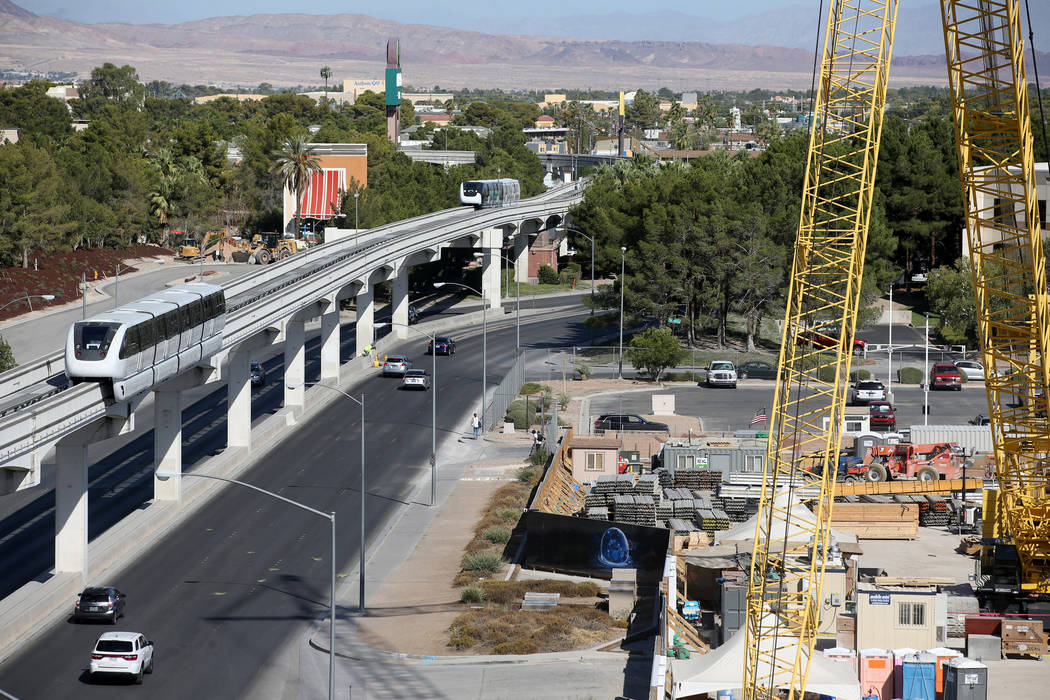Sands-Sphere station will get Las Vegas Monorail closer to completion
Is the Las Vegas Monorail back on track, now that financing has been secured for a piece of its planned expansion?
Probably not.
But the fact that the privately held company has a plan to build a station at Sands Avenue to provide access to the under-construction MSG Sphere at The Venetian — and financing in place to build it — provides new hope for the 3.9-mile, zero-emissions transit system.
If nothing else, it should for at least a few years quiet the critics who want to spend the reserves set aside to dismantle the system in the event it completely failed.
The system has foundered because there aren’t enough riders buying tickets to sustain operating costs, let alone pay for capital improvements. It filed for bankruptcy protection in 2010, and after emerging, ridership revenue has fallen every year since 2016.
I’ve said it before, and I’ll say it again: The Las Vegas Monorail isn’t as successful as it could be because it isn’t finished yet.
The new Sands Avenue station won’t go far toward reaching completion, but it sets the system up for more ridership once it and the sphere-shaped, 17,500-seat performance venue being developed by The Madison Square Garden Company is complete. The new station is expected to be engineered into the pedestrian bridge being designed to move people from The Venetian, Palazzo and the Sands Expo and Convention Center to the MSG Sphere. It will cost an estimated $13 million to complete.
The system would get closer to completion if the mile-long extension to the south from MGM Grand to Mandalay Bay — a drop-off point for people attending games and events at Allegiant Stadium — can be engineered and built. That is expected to cost between $90 million and $100 million.
It could get even more traction if the system were extended to the north from its Sahara Las Vegas terminus into downtown Las Vegas where Derek Stevens’ Circa resort is going to attract new crowds in late 2020.
And everybody knows the big enchilada would be finding a way to somehow extend the system to McCarran International Airport. At one time, there was a plan in place to extend the monorail east, then north to create a stop at the Hard Rock Hotel, then the Thomas &Mack Center before ending up at McCarran.
Would transportation aficionado Richard Branson, who backs the Virgin Trains initiative between Southern California and Las Vegas and who is converting the Hard Rock into Virgin Hotels Las Vegas next year, get behind a monorail extension if it means connecting Virgin Atlantic passengers directly to his new hotel?
One of the benefits of adding the Sands station is that the system would connect more than 30,000 hotel rooms and more than 8 million square feet of convention space. Throw in the extension to Mandalay Bay, and you can add another 1 million square feet of convention space and 11,700 more hotel rooms with the Mandalay-Luxor-Excalibur rooms.
Linking the convention centers together — the Las Vegas Convention Center, the Sands Expo Center and the Mandalay Bay Convention Center — establishes the opportunity to host larger shows and co-located events.
The SEMA Show (Specialty Equipment Market Association) and AAPEX (Automotive Aftermarket Products Expo), which will be here the first week of November, is a classic example of two separate shows with similar audiences that come annually to Las Vegas because the city’s convention infrastructure is large enough to accommodate them both at the same time.
SEMA sets up at the Las Vegas Convention Center and AAPEX at the Sands Expo Center. By the 2021 show, they should be a three-minute monorail ride away from each other. Someday, it’s possible that the Sphere would be used for automotive messaging that could serve both shows.
The monorail company will deliver a green message as it builds new sponsors and advertisers through an agreement between the company and Pharris Media Inc. CEO Patrick Pharris brought millions of dollars to the monorail company with a similar station and train sponsorship arrangement between 2000 and 2007. The message he and the monorail company want to resonate among show producers and conventioneers is that the monorail eliminates 2.1 million vehicle miles driven per year, keeping 27 tons of emissions out of the air.
Since the monorail began operating in its present form in 2004 — it actually started as a novelty attraction between MGM Grand and Bally’s in 1993 — Las Vegans have known the system isn’t perfect.
If only resort corridor bosses had realized then that setting up on the Strip would have been more useful and convenient than putting it east of Strip resorts. If only airport service would have begun during the initial rollout.
But that didn’t happen.
It’s best to work with what we have, improve it and finish it.
The Review-Journal is owned by the family of Las Vegas Sands Corp. Chairman and CEO Sheldon Adelson.
Contact Richard N. Velotta at rvelotta@reviewjournal.com or 702-477-3893. Follow @RickVelotta on Twitter.
I'm a monorail customer
I'll use the Las Vegas Monorail whenever I'm covering one of the huge conventions at the Las Vegas Convention Center.
But I really like it to get to Vegas Golden Knights games. To avoid those expensive parking fees near T-Mobile Arena, I'll park free at Sahara Las Vegas or Westgate, take the monorail to the MGM Grand and walk across the street to New York-New York and T-Mobile.
The monorail ride only costs a dollar a ride if, as a local, you buy a $20 ride pass, good for a whole year.
Cutting out the pricey parking allows me to buy after-game food at Eataly or at an MGM Grand restaurant.
Or, I can just get a meal at Sahara or Westgate instead.























